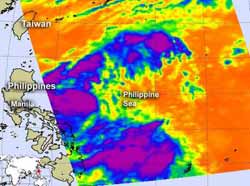Tropical Depression Dokuri weaker, but still potent

NASA's Aqua satellite passed over Tropical Storm Dokuri on June 27 on 0435 UTC (12:35 a.m. EDT). Infrared data from the AIRS instrument onboard, indicated the there were still some strong (purple) showers and thunderstorms within. Credit: Credit: NASA/JPL, Ed Olsen<br>
NASA's Aqua satellite passed over Tropical Storm Dokuri on June 27 on 0435 UTC (12:35 a.m. EDT). Infrared data from the Atmospheric Infrared Sounder (AIRS) instrument onboard indicated there were still some strong showers and thunderstorms within the system. Those cloud top temperatures were colder than -63 Fahrenheit (-52 Celsius), indicating strong uplift in the atmopshere, and thunderstorms within Dokuri that have the capability for heavy rainfall.
Infrared data shows a fully-exposed low level-circulation center. The strongest convection (rising air that creates thunderstorms that make up the system)are being pushed to the southwest due to strong northeasterly vertical wind shear.
Warnings are up in the Philippines as Doksuri (known there as Dindo) continues to move north of Luzon today. Public storm warning signal #1 is in effect in Abra, Kalinga, Isabela, Ilocos Sur, Mt. Province, Ifugao, La Union, Benguet, Pangasinan, Nueva Vizcaya and Quirino. Public storm warning signal #2 is also in effect for Cagayan, Calayan Group of Islands, Babuyan Group of Islands, Batanes Group of Islands, Apayao, Ilocos Norte.
On June 28, 2012 at 1500 UTC (11 a.m. EDT), Tropical Storm Doksuri had maximum sustained winds near 35 knots. It was located approximately 335 nautical miles north of Manila, Philippines, near 20.4 North and 120.7 East. It was moving to the west-northwestward at 17 knots. The strongest convection and thunderstorms were located over northern Luzon at this time, and are moving off the northwestern coast of the Philippines.
Doksuri has weakened as it passes to the north of Luzon. Doksuri is expected to continue tracking west and make landfall near Hong Kong in two days.
Media Contact
More Information:
http://www.nasa.govAll latest news from the category: Earth Sciences
Earth Sciences (also referred to as Geosciences), which deals with basic issues surrounding our planet, plays a vital role in the area of energy and raw materials supply.
Earth Sciences comprises subjects such as geology, geography, geological informatics, paleontology, mineralogy, petrography, crystallography, geophysics, geodesy, glaciology, cartography, photogrammetry, meteorology and seismology, early-warning systems, earthquake research and polar research.
Newest articles

High-energy-density aqueous battery based on halogen multi-electron transfer
Traditional non-aqueous lithium-ion batteries have a high energy density, but their safety is compromised due to the flammable organic electrolytes they utilize. Aqueous batteries use water as the solvent for…

First-ever combined heart pump and pig kidney transplant
…gives new hope to patient with terminal illness. Surgeons at NYU Langone Health performed the first-ever combined mechanical heart pump and gene-edited pig kidney transplant surgery in a 54-year-old woman…

Biophysics: Testing how well biomarkers work
LMU researchers have developed a method to determine how reliably target proteins can be labeled using super-resolution fluorescence microscopy. Modern microscopy techniques make it possible to examine the inner workings…





















